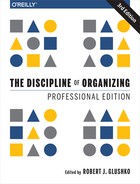10.7. Key Points in Chapter Ten
Most of the specific decisions that must be made for an organizing system are strongly shaped by the initial decisions about its domain, scope, and scale.
The impact of broad scope arises more from the heterogeneity of the resources and users in a collection rather than from their absolute number.
Larger collections need more people to organize and maintain them, creating communication and coordination problems that grow much faster than the collection.
The best way to prevent problems of scope and scale is through standardization.
Organizing systems in the same domain and with nominally the same scope can differ substantially in the resources they contain and the interactions they support if they have different categories of users.
Designers who recognize that their systems have real consequences for people should commit to measures of transparency and an ongoing process of negotiation that enables those affected to voice concerns related to any detrimental effects the technology might have on them and their communities.
For most organizing systems other than personal ones, the set of interactions that are implemented in an organizing system is strongly determined by economic factors.
An essential requirement in every organizing system is ensuring that the supported interactions can be discovered and invoked by their intended users.
Automated and computerized processes can create the resource descriptions in an organizing system and their use is primarily driven by scale.
(See §10.4.2, “About the Nature and Extent of Resource Description”)
Organizing principles depend on resource descriptions, so requirements for the former are always intertwined with those for the latter.
Overly customized and inflexible resource descriptions or arrangements cannot easily accommodate the future growth of the collection.
(See §10.5, “Designing and Implementing an Organizing System”)
Architectural thinking leads to more modularity and abstraction in design, making it easier to change an implementation to satisfy new requirements or to take advantage of new technologies or procedures.
For digital resources, inexpensive storage and high bandwidth have largely eliminated capacity as a constraint for organizing systems, with an exception for big data, which is defined as a collection of data that is too big to be managed by typical database software and hardware architectures.
The most predictable maintenance activities for an organizing system with an expected long lifetime are incremental changes in description vocabularies and classification schemes.
Another very predictable type of activity over time with organizing systems is a technology upgrade that improves its quality or capabilities without affecting the organizing principles.
(See §10.6.2, “Properties, Principles and Technology Perspective”)
The most challenging kinds of maintenance activities for organizing systems involve changes to the principles for arranging resources along with changes in the implementing technology.
(See §10.6.2, “Properties, Principles and Technology Perspective”)
What resources are being organized? Why are the resources being organized? Who does the organizing? When are the resources organized? Where are the resources organized? How much are the resources organized?
(See the case studies presented in Chapter 11, “Case Studies”)
